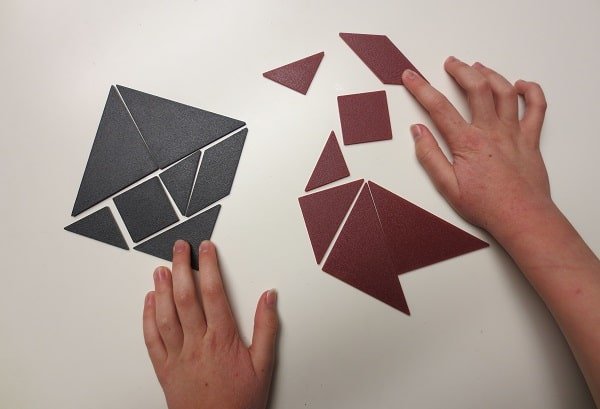Advice
Educational tips and a printable template



Tangrams for kids: A learning tool for building STEM skills
Like building blocks, tangrams can teach kids about spatial relationships. They may help kids learn geometric terms, and develop stronger problem solving abilities. They might even help children perform better on tests of basic arithmetic. But what is a tangram?
Invented in China approximately 200 years ago, a tangram is a two-dimensional re-arrangement puzzle created by cutting a square into seven pieces — seven geometric shapes called “tans” (Slocum et al 2003).
What are the seven shapes in a tangram? Each tangram puzzle contains the following:
- 2 large right triangles
- 1 medium-sized right triangle
- 2 small right triangles
- 1 small square
- 1 parallelogram
Arranged correctly, these tangram shapes can be fitted together as a large square, rectangle, or triangle. They can also be arranged in a variety of complex shapes, including fanciful ones.
There are many ways to play with tangrams. The simplest way is to let kids create their own complex shapes. But traditionally, tangrams are treated as puzzles, where players are challenged to reproduce specific designs. And there are rules.
The classic rules
The classic rules are pretty simple. To count as a standard solution, players must meet the following criteria:
- a completed design must use all of the tangram pieces;
- every piece must touch at least one other piece, even if it’s just the apex of a corner contacting another piece; and
- all of the pieces must lie flat, with none overlapping each other.
Also, in the standard, classic approach to the puzzle, the player is shown a target shape in outline only, so that the “seams” between the composite tans are concealed. Then the player attempts to recreate the shape using the seven pieces.
In essence, it’s an exercise similar to structured block play, where the challenge is to create an exact copy of a structure depicted in a diagram. But there’s a key difference.
In structured block play, the diagram provides you with explicit, visual information about where each piece goes. With a tangram puzzle, you’re left to figure that our for yourself.
As noted by Zhen Yuan and his colleagues, solving tangram puzzles appears to activate parts of the brain associated with creative thinking and trial-and-error problem-solving (Hu et al 2019).
What makes tangrams especially challenging?
The most difficult puzzles are called classic, “silhouette puzzles,” where players can’t see the internal lines defining the tans that make up a solution. In the image below, the middle row of tangrams are silhouette puzzles. The other rows provide players with explicit cues about the internal structure of each puzzle.


We can make things easier for players by providing them with lines or color cues as illustrated above. But even then, beginners — especially young children — may have difficulty matching the template. Puzzles often require the player to orient shapes in non-standard ways. You may need to turn or flip a piece to make it fit.
It’s not unusual for children to visualize certain shapes with a very particular orientation in mind. For example, students may think of a square not simply as a figure with four equal sides, but as a figure that “sits” flat along the horizontal plane (see image below). If the square is tilted from this orientation, kids might not interpret it as a square anymore. Now it’s a diamond (Clements and Sarama 2014).
This means that players may be slow to recognize the tan they need, even if the shape is right in front of them. If it’s not already oriented in a way that parallels the target orientation, they might not make the mental connection.
No wonder, then, that learning to turn and flip shapes is often a major breakthrough for players. It helps them reinterpret how pieces can fit together (Bofferding and Aqazade 2023).
What are the educational benefits of tangrams?
When we play with tans, we consider the shapes from a variety of angles and perspectives. How would the shapes look if we stuck them together? Rotated them? Slide them around into different positions?
Experiments suggest that thinking about such things — visualizing the spatial relationships between shapes in your “mind’s eye” — can boost our visual-spatial skills.
Research hints that it can boost arithmetic performance, too. When Yi Ling Cheng and Kelly Mix asked kids, aged 6-8, to perform a series of tangram-like spatial tasks, the practice session seemed to prime the brain for mathematics.
Kids who spent 40 minutes solving shape rotation puzzles performed better on a pencil-and-paper arithmetic test immediately thereafter.
Compared to crossword puzzle warm-ups, tangram-like activities have been shown to have educational benefits (Cheng and Mix 2012).
Educators recommend the use of tangrams in the classroom for various reasons, including helping children classify shapes, develop positive feelings about geometry, understand spatial relationships, decompose geometric shapes, improve spatial rotation skills, acquire a vocabulary for manipulating shapes, and learn about congruence.
Research suggests that guided play with tangrams can help children move away from simplistic ideas about shapes and develop a stronger spatial vocabulary. Tangram play can also help children learn new geometric terms and concepts without the need for formal formulas.
While solo play with tangrams can be beneficial, collaborative play with discussion and teamwork can enhance the educational experience. Studies show that interaction with others who use spatial vocabulary can improve spatial skills in children.
Encouraging children to explain their ideas, make predictions, and discuss tactics during tangram play can further enhance their spatial skills and understanding of geometry.
Exposure to different types of triangles and shapes is important during tangram play to help children understand the properties of shapes and develop a deeper knowledge of geometry.
Creating tangrams and engaging in various tangram activities can help children explore geometric manipulations, understand shape properties, and enhance their spatial skills.
Virtual tangram games can also be educational, according to the National Council of Teachers of Mathematics, as they encourage children to think critically about how to manipulate tangram pieces.
In addition to classic tangram activities, themed tangram challenges can be fun and engaging for children, allowing them to be creative and explore different shapes and designs. Collaborative play and discussion during tangram activities can further enhance the educational benefits for children. To learn more about the development of STEM skills and effective learning strategies, consider exploring the following articles on Parenting Science:
– “The benefits of toy blocks” highlights the advantages of construction play.
– “Can Lego bricks and other construction toys boost your child’s STEM skills?” focuses on structured block play.
– “Spaced learning” discusses how spacing out lessons over time can improve information retention.
– “Harnessing the power of self-explanation” explores tactics to help children learn math and science effectively.
– “STEM books and learning resources for kids” provides recommendations for educational materials, including free options.
For further reading on tangrams and children’s spatial reasoning development, reference the following articles:
– Bofferding L and Aqazade M. (2023). “Where does the square go?” Educ Stud Math, 112, 25–47.
– Bohning G and Althouse JK. (1997). “Using tangrams to teach geometry to young children.” Early childhood education journal, 24(4), 239-242.
– Cheng Y-L and Mix KS. (2012). “Spatial training improves children’s mathematics ability.” Journal of Cognition and Development, DOI:10.1080/15248372.2012.725186.
– Clements D and Sarama J. (2014). “Learning and teaching early math: The learning trajectories approach.” New York, NY: Routledge.
– Hu Z, Lam KF, Yuan Z. (2019). “Effective Connectivity of the Fronto-Parietal Network during the Tangram Task in a Natural Environment.” Neuroscience, 422, 202-211.
Additional resources and references on tangrams and children’s learning are provided for further exploration. Images and content credits are also acknowledged for transparency and credibility.
Please note that the content of “Tangrams for kids” was last updated in 10/2024, with some portions being derived from previous versions by the same author. Please rewrite this sentence.
-

 Destination9 months ago
Destination9 months agoSingapore Airlines CEO set to join board of Air India, BA News, BA
-

 Breaking News10 months ago
Breaking News10 months agoCroatia to reintroduce compulsory military draft as regional tensions soar
-

 Gadgets4 months ago
Gadgets4 months agoSupernatural Season 16 Revival News, Cast, Plot and Release Date
-

 Tech News1 year ago
Tech News1 year agoBangladeshi police agents accused of selling citizens’ personal information on Telegram
-

 Productivity12 months ago
Productivity12 months agoHow Your Contact Center Can Become A Customer Engagement Center
-

 Gadgets1 month ago
Gadgets1 month agoFallout Season 2 Potential Release Date, Cast, Plot and News
-

 Breaking News10 months ago
Breaking News10 months agoBangladesh crisis: Refaat Ahmed sworn in as Bangladesh’s new chief justice
-

 Toys12 months ago
Toys12 months ago15 of the Best Trike & Tricycles Mums Recommend























